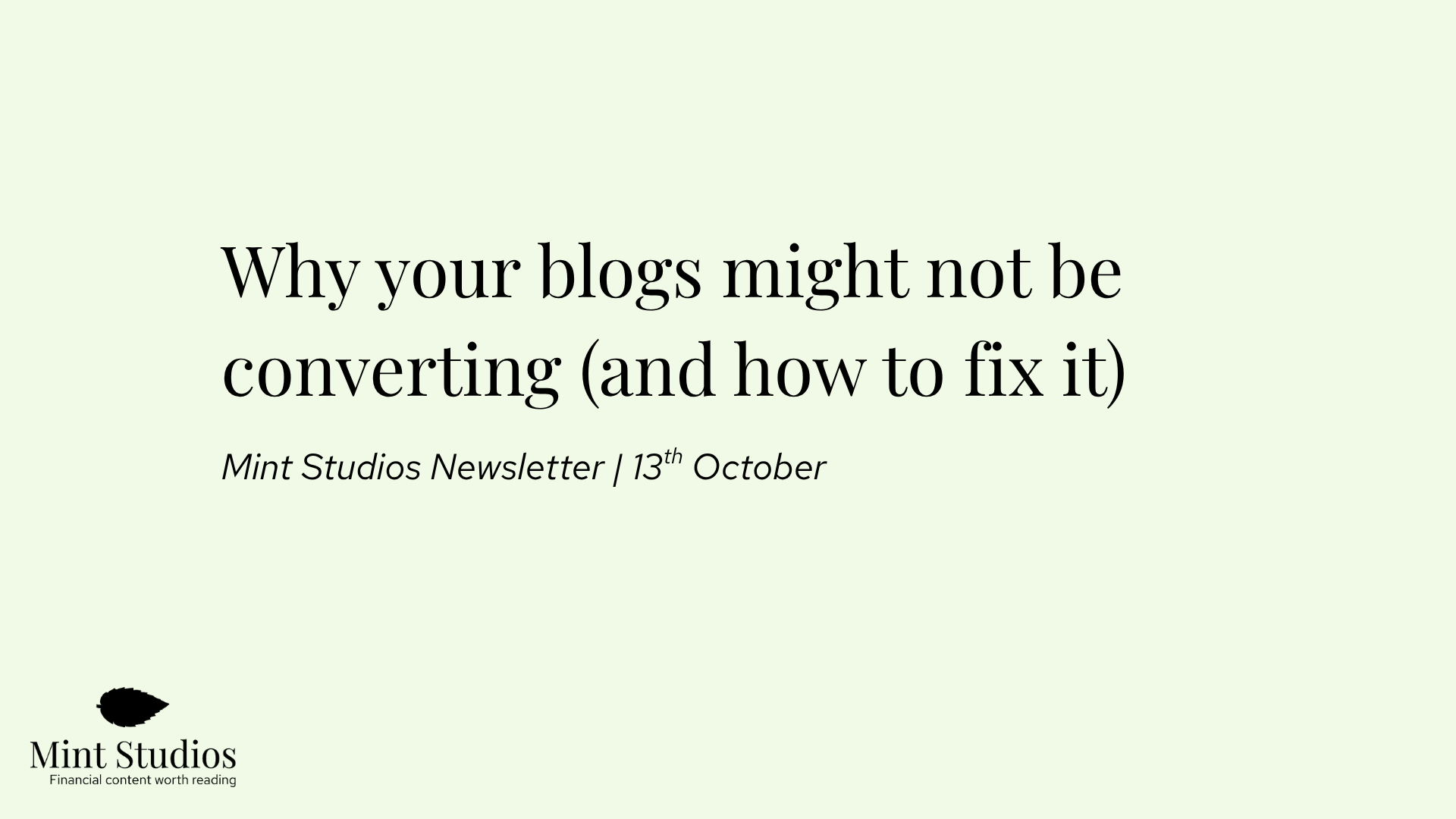Right now, as an in-house fintech marketer, you’re likely preoccupied by:
- Marketing budgets being cut.
- Fewer resources and not enough bandwidth to do what you want.
- Pressure from the leadership team to hit certain KPIs.
We recently surveyed 23 fintech marketers on how they were currently approaching their content and what their main challenges were.
One interesting fact stood out: every person who filled this question in the survey said they were publishing website blog content.

What if you could kill two birds with one stone by creating blog content that was revenue-focused:
- You could continue to publish blog content (therefore keeping budgets and resources at around the same level)
- You can start getting results more quickly, and keep the higher ups who are focused on leads and revenue happy.
We’ve worked with over 20 fintech companies, helping them create blog content that focuses on revenue and generates leads.
In this article, we will break down how you can do more with less with a revenue-focused fintech blog.
Note: are you looking to create a revenue-focused blog? We’re offering one month sprints where set you up with everything you need to run a revenue-focused blog. Learn more here
Why the blog?
There’s a few reasons:
You’re already publishing on the blog
Based on the survey we mentioned earlier with over 20 fintech marketers, we know that everyone already publishes on the blog, which means that you probably do too.
It’s likely you have a Content Management System already in place. You’ve probably already published a few blogs and the process is relatively straightforward. With a blog post, you won’t always require the design team to publish, nor a complex campaign to promote it. And once the process is in place, it’s just a matter of repeating it. You don’t need a day-long workshop to do each blog post.
With marketing budgets being cut and resources being restricted, we’re aiming to use a method that allows you to get results without having to invest too many additional resources. A blog allows you to do that.
You can rank on Google for highly targeted phrases that indicate buyer intent
Blog content has something that few marketing channels have: a built-in distribution process. That means that simply publishing also includes distribution.
As a distribution method, it’s not perfect. It takes time, and will require some knowledge of SEO. But the point is: if resources are limited and you can’t do much distribution, then the blog is a good place to start because by publishing, you are also distributing.
With the blog, you can get your content and product in front of highly qualified prospects on the most popular search engine in the world. There is no other marketing channel that is as targeted as Google with blog content. With ads, you’ll end up in front of people for whom your product is not relevant. With emails, you might be messaging them when they’re not at the right point in the buying journey.
But with Google, you’re targeting people based on their pain points and needs. Best of all, you can target people who are aware of their problem, know what the solution is and are actively looking for it. No other channel does that.
If you offer banking as a service and you rank for “account aggregation api”, then you’re targeting someone who is likely to be very qualified.
It’s a long term investment that keeps giving (and living)
Your website blog is not an expense, it’s an investment. If you continuously publish the right type of content and are ranking for the right keyphrases, you’ll get a constant stream of inbound leads and conversions for years. Although it’s a channel that takes longer to work than others, the long-term investment – when done right – can pay itself multiple times over.
And unlike a PDF or an email, if your product changes or needs updating, you simply go back to your blog post and tweak it. Your blog is a living and growth engine that keeps giving.
What type of results can you expect?
If a customer to you is worth over £5,000 per year, then the blog is even more a must when targeting and acquiring customers.
That’s because you only need a few leads to make that investment worth it. And the value of being able to get in front of the right people, is higher than the value of getting in front of more, unqualified people.
If a customer is worth £10,000 a year and you have a decent lead to close rate, then 10 inbound leads per month is very valuable. And with blog content, 10 qualified inbound leads per month is very doable.
We’ve been able to generate a substantial number of leads per month with clients where customers were worth over £50,000 per year, with articles like these:


You just need a few targeted people to read that, and you’ll get an SQL. With just a few articles per month that are super targeted towards people who are close to buying, you can bring in revenue.
If a customer is worth quite a lot, then you are leaving money on the table by not creating blog content that targets people who are close to converting.
The four pillars to creating a revenue-focused blog
How is it done? If your resources are restricted and you’re looking to focus on creating a revenue-focused blog, here are the steps you can take.
1. Start tracking the leads coming from the blog
Having the right tracking set-up is incredibly important for a few reasons:
- So you can prove to the leadership team that your content is bringing in leads
- So you can track the journey of a lead and prove marketing’s contribution to a sale (and even quantify it)
- So you can track which blog content brings in the most leads, and use that to direct your content strategy.
If you have no tracking currently set up for the blog, start here:
- Use Google Tag Manager to track clicks on each Call to Action (guide on how to do that here)
- Once that is set up, you’ll be able to see the conversions come in via Google Analytics in the Model Comparison tool (guide on how to access that here)
If you’re able to, try and track something more accurate, like:
- Form submissions
- Create an account
- App download
We’ve written a guide on how to do your tracking here: Content Attribution: How to Calculate How Many Customers You're Getting with Content
If you use Hubspot or Salesforce, set up a Hubspot dashboard so you can track metrics like:
- Number of blog sessions
- How many leads/contacts you bring in per blog post
An easy way to track performance of your blog posts is to set up a unique and separate campaign. Call it something like “Revenue focused blogs” and you’ll be able to track how many contacts are created via your blogs.
Hubspot is a goldmine of information – so if your team is already using it, make sure to take advantage of it and track as much as you can. Here’s what we can see from Hubspot:

2. Focus your content strategy and bottom of the funnel
Once you have your tracking set up, you can create a plan to focus on revenue-focused blog posts. The key here is to avoid trying to go too in-depth, trying to make tons of documents and looping in everyone.
The key premise of our strategy is to focus on the bottom of the funnel. On the prospects who already know they have a problem, what the solution is and are actively looking for it. These are the low hanging fruit, and targeting these people will get you more results than targeting people who are middle or top of the funnel.
In order to target the bottom of the funnel, you need to understand what your target market is thinking at that level in the journey. Who are they comparing you to? What are their problems? What features and benefits do they care about?
In order to find these out, here’s a simple step by step process:
1. Set up calls with a salesperson on year team, a growth person, a customer service rep, your CEO
2. Record the calls, and ask them questions like:
- What was the last prospect/company that you had a really easy time closing? What type of prospects are the ones that are the easiest to close?
- What is the product usually compared to? What are the alternatives?
- What is the most common reason people buy our product?
- What are the pain points you keep seeing?
You can find an entire list of questions you could ask your team here: How to Do Research for Bottom of the Funnel Content Marketing
3. Go through the recording and take notes of phrases that stand out, specifically:
- Pain points
- Use cases
- Problems
4. Put together some content ideas that go through the big 5:
- Alternatives to. (e.g. alternative to Paypal)
- Comparison articles (e.g. Xero vs Freeagent)
- Best of articles (e.g. best accounting software for freelancers)
- Pricing pages (e.g. how many fees do [incumbent competitor] charge?)
- Use case blogs (e.g. how do I open a bank account as a contractor?)
5. You now have content ideas that are targeting people who are close to converting. Prioritise by highest intent (so where you think someone searching this up is very close to converting), and put it in a calendar.
6. That’s it. Focus on getting 3 - 6 ideas that will last one or two months
Some examples of content ideas:
- Best accounting software for freelancers
- Payment API: when to use one and top use cases
- Competitor A vs Competitor B vs Your Product
It’s important to not get too stuck in the “strategy” part. You don’t want to spend months doing workshops, waiting for sign-off and for others to put in their input. We believe it’s best to take a “act and then ask for forgiveness” point of view: start creating content as quickly as possible, so you can get results sooner, and then get more buy-in to do the rest of content.
Focus on the low hanging fruit: the people who know they have a problem, know the solution and are actively looking for it
Often, your leadership team will want to see more results before giving you a larger marketing budget. Creating a revenue focused blog will allow you to get SQLs earlier on than with other types of content, which will then open the doors to getting a larger budget and engaging in other marketing activities.
3. Start creating content based on interviews with your salespeople
You’ve got content ideas for a couple of months where you’ll be targeting people who are close to converting. Now it’s time to execute.
Based on the survey we mentioned earlier, fintech marketers’ content team tends to be set up like this:

Which means the most common set up is all in-house, and working with someone in-house and with a freelancer.
Since you’re creating content that is bottom of the funnel, you’re likely to be targeting product managers, CTOs and people who are more technical and advanced. That means that the content you create should also be technical and advanced.
Whether you have an in-house writer or freelance writer, the approach is the same. Instead of asking your writer to do research and write the article, ask them to interview someone on your team who is an expert, and base the article on that interview.
Now, this is where things can get complicated here as well. People have schedules, people don’t have time, and often people don’t think content is a priority.
What we’ve found works best is to put a weekly call in the diary with one expert, and base all your content on an interview with them. In the B2B world, a salesperson is your best bet here. Set up a 30 min call every week, and then create content based on those interviews.
If you still have issues with scheduling and people not turning up to calls, here are some other issues which Andrea, CMO at Zai, mentions:
“Tip 1: Set up a weekly demand generation meeting
Set up a weekly demand generation call where anyone on the sales and marketing team can join. On this call, go through everything the marketing team is working on and demonstrate how Sales are contributing and benefiting.
Explain what channels you’re working on, show them the metrics and stats and walk them through your thinking but also ask them for their perspective.
This enables collaboration and gets everyone on the same page. Sales have client-facing insights that Marketing doesn't get to access so easily, leverage this knowledge and show them that you are applying it.
Tip 2: Use the language salespeople use
Instead of using the words like "traffic" and "inbound", use words like "revenue marketing" "revenue attribution". Talk in terms of leads and deals closed, so salespeople feel you understand their perspective.
When you talk about Brand awareness, remind them it’s the difference between their prospect instantly knowing which company the Salesperson is calling from versus having to explain who your company is. Marketers always focus on the pain points of our customers, but take the time to link marketing activity to solving a pain point for the Salesperson.
Tip 3: Track the entire customer journey
Set up Hubspot and Salesforce to track the entire customer journey from start to finish. Don’t stop at SALs. Andrea explains that whereas previously, a lead at Zai was 100% attributed to a salesperson, now they can demonstrate how marketing activity and campaigns directly influence and contribute to revenue.
Being able to attribute revenue to marketing and show the entire journey helps everyone understand the essential role of each marketing activity.
Tip 4: If you’re writing content based on interviews with expert salespeople, explain that the content is for lead generation
It's possible that when you first start doing calls with salespeople for your content, they'll assume that these calls are to help marketing out. But it's important to communicate that these are specifically for the benefit of the Sales team and contribute directly to sales lead generation.
And that every time someone misses a call, it prolongs the team being able to get those lead generation articles published, and consequently impacts the ability to get more leads”
On these calls, you want your writer to ask questions like:
- What are the challenges our target market face on this particular subject?
- How does our feature work?
- When does it make sense for our target market to use our feature?
- What are the top use cases?
- What are some examples of current clients using this feature?
This ensures that your content is based on expertise, that you can be product focused and go into a lot of detail. Remember, this is super targeted content, so you want to make sure that you’re including all the relevant information that a product manager or CTO would want.
4. Write for the level of your reader
If you’re in the B2B space where a customer is worth more than £5,000 per year and you’re focused on enterprise, it’s even more important to write for the level of your reader.
Don’t write beginner content, or start off an article with “What is an API”. You want to make sure you’re including the information that they need. Would your target reader want screenshots? Access to documentation?
This is why doing your weekly call with a salesperson is so useful, because they’ll often know what challenges the target market is facing and what kind of information they’re looking for.
You can read two pieces of content we wrote for our client, Zai, that is advanced, written for the level of the reader, and targeting people who are close to converting:
- Split payments API: How Zai's API can help you set up a custom payment workflow
- PayTo: How to prepare and plan for it (with use cases and examples!)
With those four pillars in place, you’ll start creating revenue-focused blog content which will help ensure:
- Your resources remain more or less the same (you can use your current freelance writers or in-house writers to do this type of content)
- You’ll begin to get results via SQLs, which will keep your leadership team happy
How can we help?
Like the sound of this approach, but not sure where to start?
We’re offering one month sprints where we come in and set up a revenue-focused blog for you, give you the resources and processes, and then let you execute. Within this month, we:
- Set your lead tracking up via Google Analytics or HubSpot
- Interview someone from growth, sales, etc so we can understand your target market’s pain points and put together bottom of the funnel content ideas
- Put together a strategy and calendar document with a 90 day content plan
- Audit and improve your current content
- Share lists of questions and our documents so your writers have something to start with
In one month you’ll be set up for success with a revenue-focused blog and a plan with how to move forward.
Interested? Click on the button below to get in touch with us.











